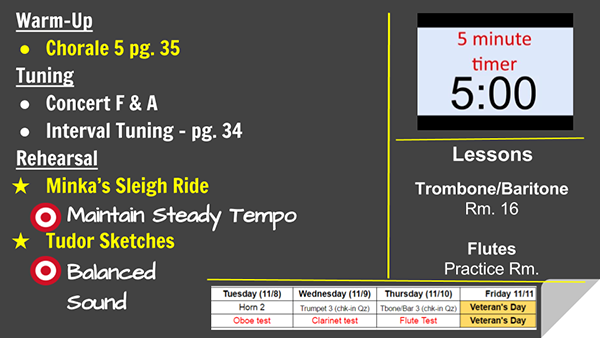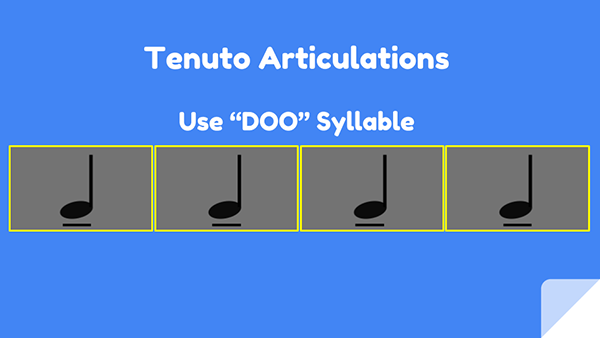
Finding the right technology tools to use in an ensemble class is not always easy to accomplish. Luckily, I’ve done the work for you! These tools are free to use, and can help elevate the focus and engagement in your rehearsal.
1. Daily Rehearsal Slide
Projecting a daily rehearsal slide is a very effective and efficient way to communicate with your students. Items you might display can include:
- Rehearsal plan
- Goals and objectives
- Lessons or sectionals
- Countdown timer
- Announcements
Simply create a customized slide, then duplicate and update for each subsequent rehearsal. In Google Slides, everything is auto-saved, creating a continuous log of rehearsal plans for the entire year. Links, videos, and audio files are easily embedded into a Google Slide as well.

Rehearsal slides are equally effective for reinforcing teaching concepts. Images, including screenshots of scores, warm-ups, or rhythm studies created with music notation software can also be added to a slide. Even if you’re using an application that cannot save graphic files, you can still take a screenshot of the music and save that as .jpeg or .png file, and paste it onto the slide.
Enhance the slides with colors, shapes, arrows, and circles to further highlight important elements of the music. Additional sections like announcements and reminders can be included as space permits.
Adding a countdown timer video (several are available on from YouTube) clearly communicates to your students when rehearsal starts. Select <Insert>, <Video>, search for “5 minute countdown timer”, and select your choice. The video will appear and the size can be adjusted to fit the slide.

Creating a daily rehearsal slide communicates pertinent information to students, and ensures that you have a well-crafted a rehearsal plan. After sharing such slides, you might take your teaching to the next level and discuss the rehearsal objectives with your students. This helps ensure everyone is reading the information and working together with a common goal in mind.
2. Kahoot
Kahoot is a game-based learning platform where students can earn points for their knowledge and speed. The platform can handle a very large number of participants, so it’s perfect for large ensembles. It can be played individually or in team-mode for students who are sharing computers, tablets, or phones.
There is even a “ghost mode” option for students to compete against themselves to beat their own score from the previous game. Time limits to answer each question can be adjusted and the quicker your students answer, the more points they earn!

Images and YouTube videos can easily be included into Kahoot questions for added engagement. This allows the director to create a Kahoot game for note names, music symbols, articulations, bowings, dynamics, and much more. Integrating video allows for the added benefit of creating performance-based questions. Search YouTube or record and upload one of your own videos.
Another great feature in Kahoot is the option to duplicate and edit quizzes that other teachers have contributed to the public Kahoot quiz gallery. Duplicating and editing existing quizzes can be a big time-saver when you need to find a quick review activity for your students.
Kahoot is an excellent activity for pre-testing students on a concept or reviewing material for a test. All data can be saved and downloaded as an Excel file to track student achievement.
3. EDpuzzle
Have you ever watched video in rehearsal then paused to ask a question or have a discussion? Maybe you’ve found a great recording of a group performing a piece you’re rehearsing in one of your ensembles. Or, maybe you need to show your marching band the video from their last practice. With EDpuzzle, comments can be inserted in a video to guide your students’ listening. Questions can also be added for each student to answer and credit given for their correct answers.
Have you ever assigned students to watch a video at home or on their device? Were you concerned they might skip through parts of the video instead of watching the whole thing? Problem solved! Just enable the no-skipping feature in EDpuzzle.
There are limitless ideas for creating an EDpuzzle activity. Examples include:
- Critical listening activity
- Jazz style analysis
- Learning flute vibrato, and
- Percussion technique lesson
Any activity can be completed as a group on the students’ devices in class or assigned as homework for a flipped classroom activity. Each EDpuzzle is assigned a unique URL to share with students. For those directors that use Google Classroom, your roster of students can be easily imported to EDpuzzle to track student completion and grades.
To learn how to get started and to view other helpful tutorials, visit the EDpuzzle YouTube channel.
Technology Implementation Suggestions
If Kahoot or EDpuzzle have perked your interest and you want to use them with your students, I encourage you to follow these suggestions.
- Make sure you know how to use the technology tool before asking your students to. Do a trial run or complete the activity as a student to experience it from their point of view.
- Prepare your students ahead of time so they know what to expect and how to navigate this new technology activity.
- Contact your technology department to ensure the wifi network can handle all of the devices being used in your lesson.
I hope you enjoy these tools as much as I do. Whichever tools you decide to use, be certain they will enhance the great things you already teach your students.